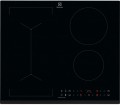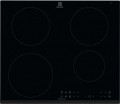Hob material
—
Enamel. The simplest and most common type of coating. Enamel combines low cost and good strength parameters. In addition, it can be produced in almost any colour. On the other hand, cleaning it can require considerable effort, and over time scratches and chips appear on such a surface.
—
Stainless steel. Steel surfaces have a nice appearance. In addition, they are stronger than enamelled ones; cracks and chips do not appear on them. Also, steel is quite easy to clean, but it is difficult to maintain its cleanliness — dirt appears easily, and even fingerprints can ruin a neat appearance. And for cleaning you need to use special tools, otherwise, you can scratch the stove.
—
Glass ceramics. Glass ceramics as a material is generally remarkable for its high thermal conductivity combined with good strength and heat resistance specs.
Schott Ceram and
EuroKera, manufacturers of this very glass ceramics, which manufacturers of household appliances install in their models, were especially successful in this. It made it possible to create original models of electric hobs, where the heating elements are located under a solid glass ceramic surface. The properties of this material allow it to be used with
induction hobs(see below). Such surfaces do not have protruding part
...s, and the location of the heaters is marked only by lines; thanks to this, you can conveniently move the dishes between the heaters, and cleaning such a surface is as simple as possible. However, there are also disadvantages: glass ceramics is less durable than enamel or steel. It requires dishes with a flat bottom, and spilling liquid on a flat surface is fraught with spreading over the entire stove and (not only). Also, this material is used in gas cooking surfaces "gas-on-glass". However, it is rather fashionable because, in addition to strength, it does not have key advantages over a tempered glass (see below) but costs significantly more.
— Tempered glass. The material used in gas-on-glass cooking hobs. it is used to make a surface over which gas burners are located. Such models have an original appearance, and the glass itself is scratch-resistant and can be cleaned well. Its strength and resistance to heat are much lower than that of glass ceramics (in fact, the latter has become the reason that tempered glass is not used in electric hobs), but these moments are more than offset by low cost.
— Cast iron. An original variant found in some premium gas models. The working surface, in this case, is made of the same cast iron as the burner grates, and the grates themselves are protrusions on the cast iron surface. It gives the entire structure an unusual, very strict appearance. And it increases its reliability: the design of the burner grates is such that they will not bend even under the heaviest dishes. On the other hand, cleaning such a surface can be quite laborious, and this option is not cheap. Because of this, there are only a few models with cast-iron surfaces on the market.Bridge mode
A function that allows you to combine two (or more) adjacent electric hotplates into one burner. Often, this mode is found in induction hobs, less often in Hi-Light, and is not used in gas hobs. Often the "bridge" looks like one continuous heater of an elongated shape, the individual parts of which can be turned on independently and are separate burners. Anyway,
the bridge mode (Bridge) can be useful primarily for working with elongated utensils — for example,
goose roasters. In addition, the design may provide various additional functions — for example, the ability to set different power settings for different parts of the "bridge" and move the dishes between them depending on the readiness of the dish. At the same time, unlike conventional burners, the heating will turn on automatically, according to the presence of dishes on the burner.
Burners power
Nominal burners power. It refers to the power consumption of the heater. This parameter allows you to estimate how much electricity the burners will spend when operating at maximum heating intensity. At the same time, the heat transfer power of different burners can be different, and the actual heating efficiency will also greatly depend on the specs of the dishes. As a result, it hardly makes sense to evaluate the working capabilities of the hob by the power of the burners. It is quite possible to proceed from the fact that the burner will be enough for a pot of the same diameter.
Burner diameter
The heating power directly depends on the diameter of the burners. And, at the same time, the performance of the device and the speed of cooking. The larger the burner, the more heat dissipation it has. Also, the diameter of the burner allows you to determine what sizes of dishes are suitable for use on the hob. Indeed, for induction models, this value is critical for high-quality heating. Burners can have the following diameter:
- small — about 145 mm, power within 1200 W;
- medium — about 180 mm, power within 1700 W;
- large — about 220 mm and more, power within 2000 watts.
Some hobs use double ring burners that allow you to adjust the diameter of the heating zone. If the diameter of the burner is 180, 200, 220 mm, then it means that the heating zone on a particular burner can be narrowed or expanded, depending on the size of the dishes used.
Country of origin
The country in which, according to the manufacturer, this or that model is manufactured. Despite the fact that most of the manufacturers are concentrated
in China, European factories for the production of household appliances have not disappeared. And certain models can be produced on them. In general, such a division into a Chinese or European plant should not particularly affect the quality of products, but still the stereotype of a reliable European assembly (
Germany,
Spain,
Italy,
Poland,
Turkey) is present in us. However, it is possible that the model may have a country of manufacture, for example, Poland, and in the store under the same article you will meet China.

